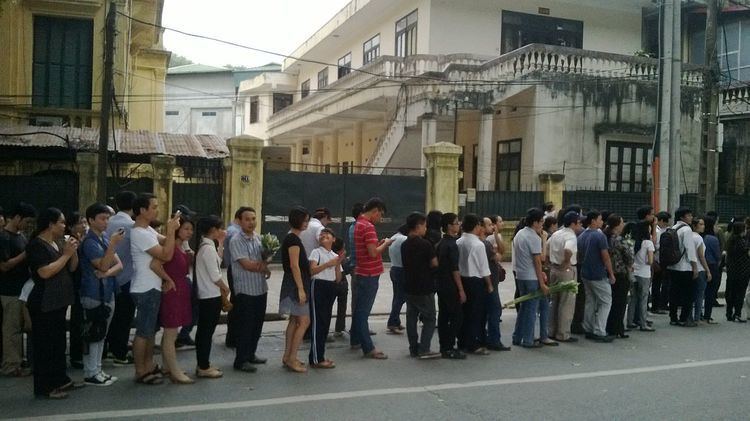 | ||
General Võ Nguyên Giáp, who led the Viet Minh forces during the First Indochina War and the North Vietnamese forces during the Vietnam War, died on October 4, 2013, after a long stay at the 108 Hospital in Hanoi. The official Vietnamese news agency did not officially confirm it until a day later, when they announced a two-day national funeral to be held the following week, on October 12 and 13, which would be presided by all the top government officials. His body laid in state at the National Funeral House in Hanoi on October 12, before being buried in his home province of Quang Binh the following day. His funeral was broadcast live nationwide by the state broadcasters, VTV and VOV.
Contents
Death
Giap was hospitalized at the 108 Hospital in 2009. After his 100th birthday, Giap's health deteriorated as he slowly lost the ability to both speak and walk. In 2011, VTV showed footage of him voting (from a wheelchair) to dispel rumors of his failing health. At 6:09 PM on October 4, 2013, he died after a four-year stay at the hospital, at the age of 102. According to East Asian age reckoning, he was 103.
Domestic
In Vietnam, news of Giap's death spread quickly through the local social media, especially through Facebook, before the government-controlled media began to pick it up. VnExpress, an online newspaper, reported the news more than four hours later, and domestic media began to report the story. However, before an official acknowledgement from the government, the media could only briefly mention the news without any commentary.
Fully one day later, the official news agency acknowledged the news that Giap was dead and announced a national funeral. There was an immediate outpouring of grief in the country where he is highly revered and many people regard him as second only to Ho Chi Minh. His family opened his residence for visitations and hundreds of thousands of people came to pay their respects before the official funeral.
International
National funeral
Immediately after news of Giáp's death spread but before it was officially acknowledged, there was widespread speculation about the nature of his funeral. According to current regulations, only people holding or having held the top positions of general secretary, president, prime minister, or chairman of the National Assembly are entitled to a national funeral (quốc tang). Võ Nguyên Giáp, who was a former Politburo member and a former deputy prime minister, was automatically be entitled to a state funeral (lễ tang cấp nhà nước). However, protocols do allow for exceptions when the deceased's stature is higher than their official position.
Upon acknowledging General Giáp's death, the government announced plans for a national funeral to be held on October 12 and 13. The Funeral Committee consisted of 30 people, headed by General Sectetary Nguyễn Phú Trọng. The National Funeral Arrangements Committee, headed by deputy prime minister and Politburo member Nguyễn Xuân Phúc, was tasked with making the arrangements for the funeral and burial ceremonies. General Giap's body lied in state at the National Funeral Hall, where mourners could pay their respect beginning on October 12. While the main ceremony took place in Hanoi, simultaneous memorials were also held at the Reunification Palace in Ho Chi Minh City and the Provincial People's Committee Office in Quảng Bình, his home province. Immediately after the funeral ceremony on October 13, his body was flown to Quảng Bình, where he was buried in Vũng Chùa - Đảo Yến, a location near the coast. As his resting place is at a remote location, workers had to work quickly to pave the road to facilitate the burial.
